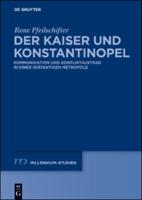Der Kaiser und Konstantinopel
Kommunikation und Konfliktaustrag in einer spätantiken Metropole
| dc.contributor.author | Pfeilschifter, Rene | |
| dc.date.accessioned | 2021-12-07T16:15:51Z | |
| dc.date.available | 2021-12-07T16:15:51Z | |
| dc.date.issued | 2013 | |
| dc.identifier | ONIX_20211207_9783110266887_56 | |
| dc.identifier | OCN: 870590008 | |
| dc.identifier.issn | 1862-1139 | |
| dc.identifier.uri | https://library.oapen.org/handle/20.500.12657/51701 | |
| dc.language | German | |
| dc.relation.ispartofseries | Millennium-Studien / Millennium Studies | |
| dc.subject.classification | thema EDItEUR::N History and Archaeology::NH History::NHC Ancient history | en_US |
| dc.subject.classification | thema EDItEUR::N History and Archaeology | en_US |
| dc.subject.classification | thema EDItEUR::3 Time period qualifiers::3K CE period up to c 1500 | en_US |
| dc.subject.other | Emperor | |
| dc.subject.other | Roman Empire | |
| dc.subject.other | Late Antiquity | |
| dc.subject.other | Byzantine Empire | |
| dc.subject.other | Political System | |
| dc.title | Der Kaiser und Konstantinopel | |
| dc.title.alternative | Kommunikation und Konfliktaustrag in einer spätantiken Metropole | |
| dc.type | book | |
| oapen.abstract.otherlanguage | How did a Late Roman emperor stay on the throne? His position was always precarious, and in contrast to a modern hereditary monarch he could always lose power or even his life to a usurper. The Eastern emperors resided in Constantinople from 395 to 624 without a break. This book shows how they sought the support of the army, the populace, the clergy and the capital`s elite, how they gained it, and how they sometimes lost it. The result is a new picture of the socio-political system of Constantinople and of the Late Roman Empire in general. | |
| oapen.identifier.doi | 10.1515/9783110266887 | |
| oapen.relation.isPublishedBy | 2b386f62-fc18-4108-bcf1-ade3ed4cf2f3 | |
| oapen.relation.isbn | 9783110266887 | |
| oapen.relation.isbn | 9783110265903 | |
| oapen.series.number | 44 | |
| oapen.pages | 722 | |
| oapen.place.publication | Berlin/Boston |

